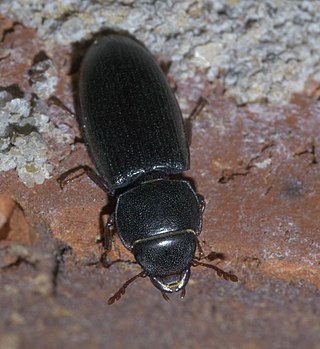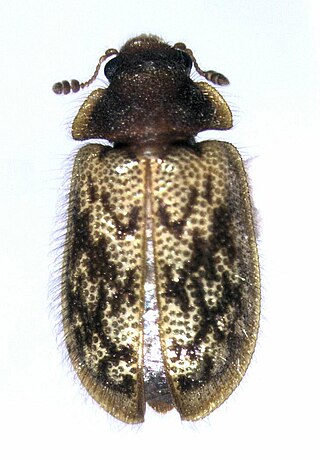
The sap beetles, also known as Nitidulidae, are a family of beetles.

The longhorn beetles (Cerambycidae), also known as long-horned or longicorns, are a large family of beetles, with over 35,000 species described. Most species are characterized by extremely long antennae, which are often as long as or longer than the beetle's body. In various members of the family, however, the antennae are quite short and such species can be difficult to distinguish from related beetle families such as the Chrysomelidae. The scientific name of this beetle family goes back to a figure from Greek mythology: after an argument with nymphs, the shepherd Cerambus was transformed into a large beetle with horns.

Cleroidea is a small superfamily of beetles containing over 10,000 species. Most of the members of the group are somewhat slender, often with fairly soft, flexible elytra, and typically hairy or scaly.

Staphylinoidea is a superfamily of beetles. It is a very large and diverse group with worldwide distribution.

The Boridae are a small family of tenebrionoid beetles with no vernacular common name, though recent authors have coined the name conifer bark beetles. The family contains three genera. Boros is native to North America and northern Eurasia, Lecontia is endemic to North America, while Synercticus is found in Australia and New Guinea. The larvae of Boros are found under bark and are especially associated with standing dead trees (snags), typically pines, found in old-growth forests. Lecontia larvae are found inhabiting damp parts of the root system of dead standing trees. Little is known of the life habits of Synercticus.

Prostomidae is a family of beetles with no vernacular common name, though recent authors have coined the name jugular-horned beetles. They are often found in dead wood. The family consist of two extant genera with about 20 species. Prostomis americanus is known from North America. Other species of Prostomis are found in Europe, Africa, the Pacific region and East Asia. Species of Dryocora are known from New Zealand, Australia and Tasmania.

Agyrtidae, or primitive carrion beetles, are a small family of beetles belonging to Staphylinoidea. They are found in mostly temperate areas of the Northern Hemisphere and in New Zealand.

Melyridae are a family of beetles of the superfamily Cleroidea.

Trogossitidae, also known as bark-gnawing beetles, are a small family in the superfamily Cleroidea. Many taxa formerly within this family have been removed to other families, such as Lophocateridae, Peltidae, Protopeltidae, Rentoniidae, and Thymalidae. Members of the family are generally predatory and/or feed on fungi, both in adult and larval stages, and are generally associated with wood, being found under bark or inside bored tunnel galleries. There are about 400 species in 25 genera in the family under the new, restricted circumscription, as opposed to 600 species in over 50 genera in the old definition. The oldest fossil assignable to the modern, more restricted definition of the family is Microtrogossita from the mid-Cretaceous Burmese amber of Myanmar, which has close affinities to the Trogossitini, indicating that the family had already considerably diversified by this time.

Temnoscheila is a genus of bark-gnawing beetles in the family Trogossitidae, historically often misspelled as "Temnochila". There are about 19 described species in Temnoscheila.

Egoliinae is a subfamily of beetles in the family Trogossitidae. Members are native to South America and Australia. They are thought to be predatory.

Artematopodidae is a family of soft-bodied plant beetles in the superfamily Elateroidea. They are mostly found in understory forest foliage. The life history of the group is obscure, larvae of the genera Eurypogon and Macropogon likely feed on moss, while the larvae of Artematopus have been fed insect remains. The oldest fossils of the family date to the Middle Jurassic.

Grynocharis is a genus of bark-gnawing beetles in the family Lophocateridae. There are at least four described species in Grynocharis.

Tenebroides is a genus of bark-gnawing beetles in the family Trogossitidae. There are at least 20 described species in Tenebroides.

Peltis is a genus of beetles found in North America and Europe, and the sole extant member of the family Peltidae, formerly included in the Trogossitidae. Members of this genus are dark, averaging from brown, to dark brown, to black. They are small, wide, and flat-bodied with wide, ridged elytra. Fossil species of this genus are known from the Eocene aged Florissant Formation of the United States, as well as the Baltic amber of Europe.

Lophocateridae is a family of beetles in the superfamily Cleroidea, formerly included in the Trogossitidae. Members of the group have a variety of ecologies, including as predators of other insects, as fungivores, or are phytophagous.

Protopeltis is a genus of beetles. It contains two species native to New Zealand. It was formerly considered a member of Trogossitidae, but is currently placed as the only member of the family Protopeltidae within the Cleroidea. The larvae have been collected from the fungus infested bark of dead Nothofagus trees. Adult gut contents indicate that they are mycophagous, feeding on probably Hymenochaete fungi. This is also presumably true for the larvae.

Rentoniidae is a family of beetles belonging to Cleroidea. The species were originally included in the family Trogossitidae. They are around 1–2 mm in length, with spherical bodies. Members of the family are native to the Southern Hemisphere, being found in Australia, New Zealand, New Caledonia and South America. They have been found on flowers, under the bark of dead trees, and in leaf litter, and members are known to be pollenivorous or fungivorous.

Thymalidae is a family of beetles in Cleroidea. They were formerly included in Trogossitidae. Members of the subfamily Decamerinae are found in Central and South America, and are associated with flowers, while Thymalus, the only member of the subfamily Thymalinae is found across the Holarctic realm, as well as parts of the Oriental realm, like southern China and Thailand, where they are found associated with the bark of trees. It is assumed that Thymalus larvae feed on fungus in decomposing wood.


















